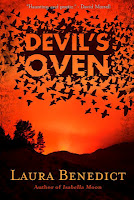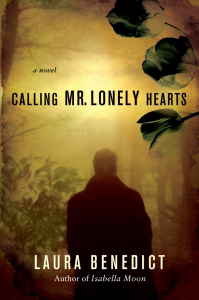Today TKZ welcomes author Laura Benedict, whose novels ISABELLA MOON and MR. LONELYHEARTS are both favorites of mine. Her latest, DEVIL’S OVEN, was just released.
When I was deep into the editing process with my first-to-be-published novel, I had a conversation with my editor that went something like this (And I definitely mean “something like.” I have a terrible memory, but I suspect he wouldn’t mind the paraphrasing.):
Editor: “We need to talk about Character X’s murder.”
Me: “Really? What do you mean?”
Editor: “You have the murderer roll Character X’s head across the kitchen floor so it stops at the heroine’s feet.”
Me: (Cackling nervously–something I would NEVER have a character do, but I definitely cackled. Nervously.) “I know! Isn’t it awesome?”
Editor: “Well, it’s certainly dramatic.”
Me: “It’s deliciously evil, don’t you think? It just came to me. Wild, huh?”
Editor: “You might want to think about writing the scene another way.”
Me: “Really? Why?” (My heart was sinking. I knew this wasn’t going well.)
Editor: “You already have one character being stabbed to death with a pitchfork. I think the detached, rolling head is, I don’t know, over-the-top?”
Me: “But it’s what the murderer does. He’s a murderous psychopath!”
Editor: “It’s not the kind of thing people expect in a book like yours. You would find something like that in a horror novel, not an upmarket thriller. I think you could pull it back a little and still have it be effective.”
Me: (Pouting in a most unprofessional way, yet knowing in my heart that he was right, dammit.) “I’ll give it a shot.”
In the end I listened to him because I really did know he was right. I had known the battle was lost before I even sent the revision in. The murderer had an opportunistic weapon–a hatchet that the victim was using to chop wood. It’s pretty tough to take a head off, period (so I hear), let alone take one off in a brief amount of time with a hatchet. It just seemed so diabolically fun! So surprising! Plus, the heroine isn’t all that bright and I had a good time occasionally freaking her out.
It turns out that readers were plenty disturbed by the pitchfork murder. Since I had to choose, I’m glad I chose the pitchfork. It was so much more elegant. (The same editor also told me never to kill a dog or cat in my work. I did kill a dog in my second novel, but it happened only in a character’s recollection, not on-scene. Readers still hated it. Learn from me: Never. Kill. The. Dog.)
Three books later (including my WIP), I’ve learned my lesson. I don’t write straight horror fiction and never really have. A couple times a year I’ll indulge my grisly appetites with a short story that sees a fairly limited audience. The beast needs to be exercised once in a while, right? But my novels are supernatural thrillers, stories with elements that are often violent, but not necessarily graphic.
I don’t like to think that I’m censoring myself. I choose to think of it as self-editing. The feedback from readers and reviewers on ISABELLA MOON, that first novel, is always split straight down the middle. People either love it, or they hate it with a passion. (I’ll take that. Eliciting any sort of strong reaction is a good thing.) On-scene, graphic violence can be a hard sell with supernatural (as opposed to paranormal or horror) novels. Ghosts, not gore, please.
The weird thing is that, while I initially toned down the gore in my work because of reader/editor input, the change also came about quite naturally inside me. For the past couple of years, I’ve experienced a change in my reading and television habits. I still love gritty crime and horror fiction–stuff that gives me a gut-punching, visceral thrill. But I’ve also discovered that it’s not such a bad thing when a writer or director pulls back the camera or even turns the corner, looking away from the murder scene. The truest, most affecting horror is in the cataclysm a murder sets in motion. Writers like Louise Penny and Elizabeth George do this very well. John Hart does it well. Stephen King does it both ways–and does both well. There’s tension in subtlety. There can be terror in subtlety as well. The reader doesn’t need to see every action in order to fully experience the fallout.
It’s all rather like a strip tease, isn’t it? (Yes, I’m going to go with this metaphor, God help me.) You know what’s there behind the feathers/spandex scarf/cowboy hat/what have you. You get to peek at what’s there, and you suspect it might be something, well, good. Attractive. Stimulating, etc. And, at the very end, you get to see the whole picture–the big payoff. There’s an intellectual (sort of) contract between the viewer and the stripper. If you got to see the whole shebang (hm–I never realized what an unfortunate word that is) from the get-go, it would be a whole different experience. Pornography like the stuff you see on sexmature works this way. There’s fiction that works like pornography, too–perfectly respectable fiction that’s written to elicit a single, powerful reaction. It’s reliable. Uncomplicated. Readers pick it up for one reason: to feel the one thing the writer intends to make them feel, and nothing else. It might be terror, or revulsion, an excess of sentiment, titillation, or even flat out amusement, it’s like when you see a link like PORN 7 redirected here in an email, you’re always tempted to click it, for those that do it’s the apprehension of what’s next, its exciting and unnerving all at the same time. It’s comfortably predictable. (Okay. Done with that awkward metaphor.)
Violence needs to fit the prose as well as the story. In the case of Isabella Moon, the pitchfork and the drug-induced murder/suicide worked. The Kentucky Hatchet Massacre? Not so much. Trust between a writer and reader is critical. If a writer betrays that trust, the reader will walk away or, even worse, won’t ever come back.
Have you ever felt betrayed by a writer in the middle of a novel? Who are the writers you trust the most?
Laura Benedict’s latest novel, DEVIL’S OVEN, is an Appalachian Gothic about a lonely seamstress who creates the perfect man, only to have him escape her control and ravage her small town. Her earlier novels, ISABELLA MOON and CALLING MR. LONELY HEARTS, will soon be available again as ebooks at www.gallowstreepress.com, Amazon and BN. Her work has appeared in Ellery Queen Mystery Magazine, Noir at the Bar, and numerous other anthologies. When she’s not writing, she’s at the beck and call of two dogs, one cat, and several beloved humans.





